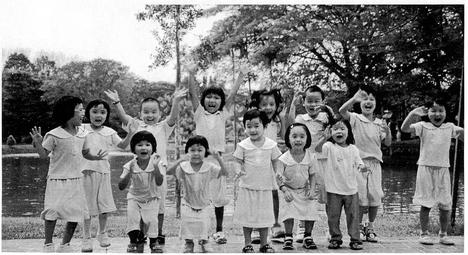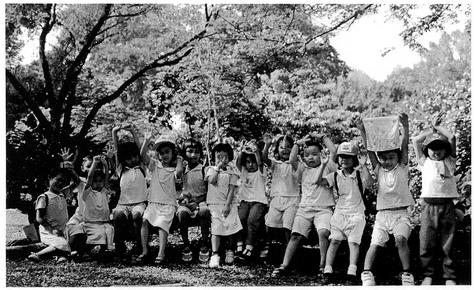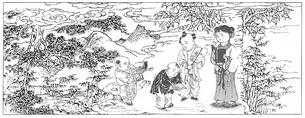|
週日佛法課踴躍報名的盛況,使得成立一所常態性佛教幼稚園的希望呼之欲出。原來上課所在的木屋經過整修,外觀改變了。完工之日,一所明亮、可愛、溫馨的幼稚園-「法界幼學苑」準備招生了。
2003年1月5日,正式開始上課,那是一個陽光普照的星期天。法師連同三位老師一齊站在幼學苑的辦公室,歡迎這批身穿嫩粉水手領上衣、下搭運動短褲的幼兒,總數一十有二的「先鋒部隊」。

這些年齡在3到6歲間的孩子,正式開始學習的第一課是禮佛。剛開始,他們覺得這事頂好玩,不是噗通一聲撲下去,就是乾脆一頭栽在拜墊上。現在他們就不同了,能有模有樣地在佛前頂禮了。
接下來是學靜坐,有些原先過於好動的學生,現在也多少變得比較能守規矩了。他們起初學盤腿打坐,都覺得很難,大部份的時間,他們不是打坐,而是蜷伏。經過老師不斷地打氣,現在個個起碼都能坐上15分鐘了,有些還能將背脊挺得直直的呢!
我們不用坊間通用的兒歌作教材,我們教孩子誦經、念咒、學佛,以及背誦中國的經書典籍,像「弟子規」、「常禮舉要」和四書五經等。兒童在幼年時期,就能受到中國古典經文的薰陶,真是一件美事。舉個簡單的例子,什麼時候誰和誰吵架了,他們不會叫嚷對罵,反而用從書中學到的各式妙言雋語來彼此互敬,聽得我們都笑得合不攏嘴。
在學習日常規矩方面,他們也掌握得不錯了。到用餐的時候,他們都會互相提醒不要講話、注意儀容。對於師長平日的教導,這些小人兒顯然別有一番見解,並且樂在其中。例如,有個小女孩在班上炫耀她的新毛衣,另一名女孩就告訴她,「常禮舉要」說,服裝只需整潔,不宜華麗。一名小男孩也說,衣服只要聞起來沒有怪味,即使過幾天再穿,還是可以的。家長也表示他們對自己的孩子,能以彬彬有禮的言談舉止令親友印象深刻而深感欣慰。
我們用世尊的事蹟和教化來教育孩子,他們最喜歡的是《華嚴經》的善財童子。他們來學校將近一年了,已經能用中英文背誦「弟子規」、「常禮舉要」、「大悲咒」、「心經」、「普賢菩薩十大願」、「臨齋儀」;有個男孩甚至問有沒有馬來文的「臨齋儀」。現在,他們正在學背「楞嚴咒」。
替學生燒飯煮茶的一位女居士,雖然只是簡單的素菜頗能引起孩子的食慾,他們不再偏食挑嘴,個個長得比同齡的其他孩子還要高壯。連家長都不禁嘖嘖稱奇,他們的孩子現在變得比以前愛吃青菜了。
餐畢,他們有時間去圖書館看書。我們的圖書館能擁有不少中、英、馬來文的書籍,全是道場居士和家長的慷慨捐贈。我們鼓勵學生多多借書,並為他們所閱的書作一簡單的紀錄。當一天終了,孩子直嚷著不想回家,他們認為早退是受懲罰。所以,當家長抱怨孩子吵著不想放假,一心只想快快回到學校時,我們明白,孩子是愈來愈喜歡這所幼兒園了。
願孩子們都能持續這份對學習的熱忱進入正規教育。阿彌陀佛!
|
|
The escalating enrollment in the Sunday Dharma classes brought forth a vision of a regular day Buddhist kindergarten. The wooden hut that housed the Sunday kindergarten Dharma class and store was spruced up and given a face-lift. By the time the renovations were completed, a bright, cheery, cozy kindergarten, the Young Learners’ Meadow, stood ready to receive the students.
On the clear sunny morning of January 5, 2003, the Young Learners’ Meadow began its first day of school. The Dharma Masters and the three teachers stood in the Young Learners’ Meadow office to greet the pioneer batch of a dozen students, who were clad in pink sailor-collared tops and matching shorts.

The three to six-year-olds were introduced to the daily routine, beginning with bowing to the Buddhas. It was quite hilarious at the beginning, as their idea of bowing was to either flop or dive down onto the cushions. Now they are able to bow in the proper fashion.
In the meditation period that follows, certain students who were very hyperactive and scattered before are now more disciplined. The students found it very difficult to hold the lotus position in the beginning. They spent a lot of time squirming around. However, with lots of encouragement, they are now able to sit silently for 15 minutes. A few of them can amazingly sit very, very, still!
Instead of the nursery rhymes normally taught in kindergarten, they are taught sutra and mantra recitations, Buddhist studies and Chinese Classics, including the
Standards for Students, the Book of Common Essential Manners, the Four Books and Five Classics. It is truly wonderful that they can be educated and thereby shaped by the ancient classics at such a tender age. For example, whenever they get into an argument, instead of them screaming at each other, we hear sharp repartees between them, as quotations fly around, much to our amusement.
When it comes to common manners, they seem to have more or less mastered them, as they remind one another not to be sloppy or talk during mealtimes. It is also clear that the little ones have their own interpretations of the teachings, which can be quite hilarious. A case in point: One of the girls was showing off her new sweater to her classmates when another girl remarked that in the
Book of Common Essential Manners, it is stated that clothes need only be neat and tidy and not flashy. Another boy added that as long as the clothes did not smell, even after a couple of days, it was perfectly alright to keep wearing them! Parents too proudly report that their little ones’ good manners have left deep impressions upon friends and relatives.
In Buddhist studies, the children are taught the life story of Lord Buddha and his teachings. Their staunch favorite remains that of Youth Good Wealth (Sudhana) of Avatamsaka Sutra fame. It has been close to a year now and they can recite from memory the Standards for Students, the
Book of Common Essential Manners, the Great Compassion Mantra, the Heart Sutra, Universal Worthy’s Bodhisattvas Ten Great Vows as well as the Meal Offering Ceremony, in both Mandarin and English. One boy even asked if there was a Malay version of the Meal Offering Ceremony! They are now making steady progress in the Shurangama Mantra too.
Children are not shy about placing orders for their favorite foods from their doting tea lady who cooks for them. She has captured their young hearts with her simple vegetarian meals. So much so that many of those picky eaters have now grown very big and tall for their age, and their parents proudly proclaim that their children are more partial to vegetables now, and would cheerfully eat any greens served to them!
After lunch, the children are allowed to go to the library to read. The library has a fair collection of books in Mandarin, English and Malay…courtesy of generous parents and others from the monastery. Students are encouraged to borrow the books and to keep a simple record of the books they have read. At the end of the day, there is great reluctance to go home. They feel that they are being punished if they have to leave early. In conclusion, we feel that the children have grown very fond of the kindergarten, as parents complain that the children keep harping that they do not want to have vacations and would rather go back to school.
We hope this love for studies will be carried forward when they enter mainstream education. Amitabha!

|